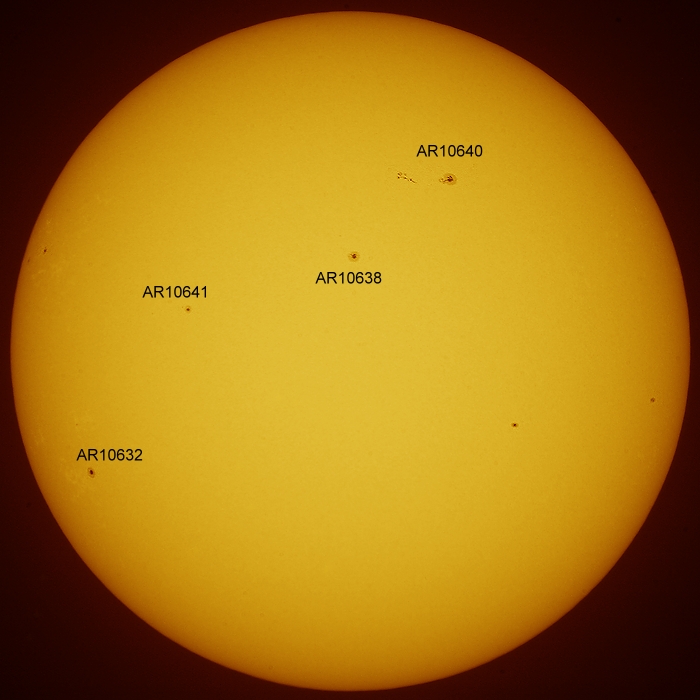
Perhaps the most obvious feature of the sun is the sunspots that characterize the photosphere. The base temperature of the 300-km deep
photosphere is approximately 6400 °C whereas the sunspot regions are characterized with areas of relatively lower temperature (around 4800 °C
for the umbral regions and 5900 °C for the penumbral regions) and increased magnetic activity (up to 3000 times the average magnetic field of
the sun). Due to the differential rate of rotation of the solar disk (26 days at the equator and 36 days at the poles), there is a "twisting"
of the magnetic fields which surface to the photosphere producing sunspots. Typically, these spots and groups are found to lie + 30°
of the solar equator and can physically be many-fold times larger than our planet! As the images below indicate, sunspots are characterized
with a dark core, the "umbra", where the temperature is about 1600 °C less than the surrounding temperature of the photosphere whereas the
less darker envelope which typically encompasses the umbral region, the "penumbra", is about only 500 °C less than the surrounding
photospheric temperature.
Studies have shown sunsplot activity to exhibit an eleven-yr cycle with virtually little sunspot activity during the minima of the cycle
whereas frequent sunspots and associated groups dominate during the maximum of the same cycle, typically approximately 4.5 years after the
minimum. During the solar maximum, we also have frequent filaments, flares and prominences (see here) which include ejected material from the sun's outermost "shell", the chromosphere, that reaches earth causing, for
example, geomagnetic storms that produce the well-known and beautiful aurora borealis and australis.
Note: The sunspot group AR10640 in the image below is the most dominant group on the
perihelion Sun today. It is categorized as Zurich class Dai and is
located at (28° N, 06° W). The other prominent groups visible in the image below are AR10632, AR10638 (Zurich class: Dao, 13° N, 06° E)
and AR10641 (Zurich class: Cao, 05° N, 39° E).
Further details for these active regions are available
here.
|
Body: Sun Mass: 332,900 x Earth Mean Eq Diameter: 109.1 x Earth Distance: 147.1 million km RA / Dec: 08h 53m 05s / -22° 52' 39" Diameter: 31.53' Magnitude: -26.8 Light Time: 0h 8m 27.3s |

|
Date: Jan 02, 2013 12:50:57 UT+2 Location: Athens, Greece Equipment: AP 160 f/7.5 StarFire EDF AP1200GTO GEM AP 2x Conv Barlow Canon EOS 5D Mark I Baader UV-IR/Cut Baader ND-5 (full-aperture) Exposure(s): 1 x 1/500 sec ISO 200 RAW image format 4368x2912 image size Manual Mode Software: Digital Photo Pro V1.6.1.0 Photoshop CS5 Processing: Grayscale Unsharp Masking Brightness/Contrast Levels Resampling Cropping JPG Compression |